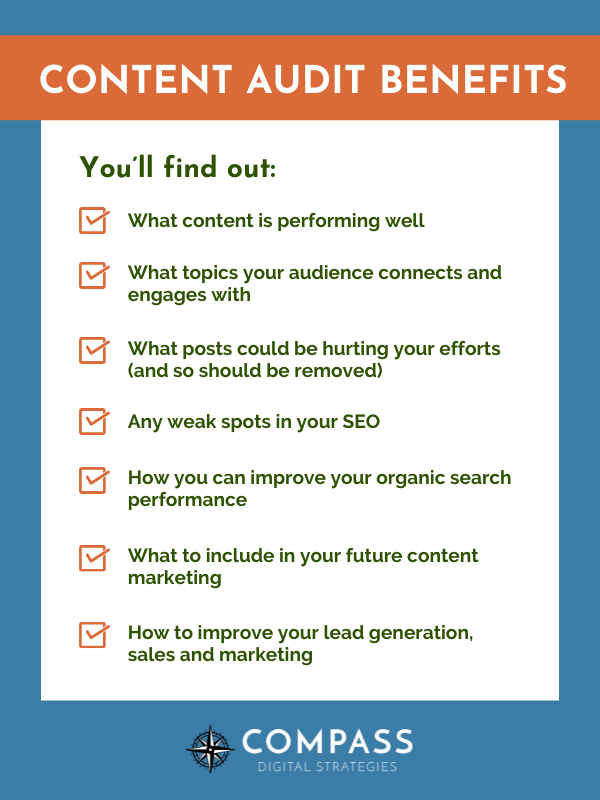It’s a common mistake to regard SEO and content marketing as separate digital marketing strategies. Contrary to that belief, both are quite interconnected. They complement each other to the point where one cannot work in the absence of the other. Without high-quality and relevant content, your SEO will not generate desired results. No wonder the global content market is growing at such a rapid pace.

Source: https://startupbonsai.com/content-marketing-statistics/
Considering all those factors, an SEO content audit is one of the primary steps in building digital marketing strategies for a website. Do you know how to audit your content? Or why it is important? Let’s get some answers.
What is SEO Content Audit?
Not sure what is a content audit? Let’s get some clarity on that. It is a systematic process of curating and evaluating the content published on your website. It directly links to the SEO strategy, as quality content is not just about optimizing with appropriate keywords. The content should be relevant and answer important search queries. For actionable results, you should audit content in:
Webpages
Landing pages
Blogs
Slide decks
Videos
Product descriptions
Whitepapers and more.
As important as content auditing is for SEO strategies to work, it can be quite daunting. But why is it so essential? Let’s find out!
Why is SEO Content Audit Important?
With facts, stats, and trends changing so rapidly in this Digital Age, your content must be accurate and relevant. That’s where SEO content audit can help you by answering the following questions:
What content do you have currently?
Is that relevant?
Is that valuable to the target audience?
Can people find the content?
How can they find it?
Is the content accurate?
Is your content performing well?
A content audit provides adequate answers, guiding you to tweak and modify the content marketing strategy. You can improve the quality of your content, thus boosting the SERPs and overall SEO performance of the website.
How do you Conduct Content Audits?
Now we come to the key point of this write-up, which is how to do a content audit. Here’s a step-by-step guide.
1. Goal Setting
Content audits tend to be lengthy and extensive. So without a proper plan, you might lose direction and fail to accomplish the result. So, begin by setting your goals. Define your objectives and metrics to analyze the content audit. It can be to:
Improve the content quality
Improve SERPs for particular pages
Change the structure of your website
Remove outdated, inaccurate, or irrelevant content
Enhance engagement for better conversions
Your audit actions will change based on your objectives. To determine the goals first.
2. Content Classification
Now that you have the goals in place your next task is to curate the content based on specific categories. You need to collect and classify the content on your website for better inventorying and more clarity when strategizing.
Start by determining and identifying the content you want to audit and then collect the URLs. You can do it manually by collecting the data on a spreadsheet. Or else you can use an online content audit tool (a better option for bigger sites).
After collecting all the URLs of the target content, it’s time to put them under different categories maintaining details like:
Page URL
Author of the content
Source (which team produced it)
Date and time of publishing
Content title
Content Type (blog, social media post, video, case study, client testimonial, infographic, etc.)
Goals (traffic, backlinks, leads, conversions, etc.)
Words
Comments
Shares on social platforms
Categorizing the content systematically helps you identify which content is performing well and which needs tweaking or removal.
3. Metrics and Data Analytics
You already have a plan to audit the content and the categories. The next step is diving into the metrics, to understand how the content is performing. It will help you assess the performance of your website. Here are a few handy tips:
You should audit the past content to see how those are performing. Only then you can understand what kind of content you need to publish in the future. It’s best if you go back at least one year and start collecting data from there. You can gather past content URLs using Google Analytics and similar tools.
Once you are done collecting data on the past content, you can use the same strategy every week on the newly published content. Create a consecutive sheet and add the stats from each week. This makes it easier to track the content performance, and you can see the graph going up and down.
Additionally, there are certain metrics that you should track, like:
Comments by the target audience
Social shares
Organic traffic through your content
Bounce rate
Backlinks generated through the content
Time spent on the page
Unique visitors to the page
Pages per search session
Number of return visitors to the page
Source of traffic and conversions
You can also track the performance and, accordingly you can tweak it to improve the performance of SEO Meta tags like titles and descriptions. Don’t forget to analyze the UTM parameters, which pages are generating the most traffic, leads, and sales, along with email metrics. Also, it is equally important to repurpose content that has performed well in the past.
4. Actionable Steps to a Robust Content Strategy
Now that you have gathered all essential data and metrics, related to the content, it will be easy to determine which content is performing well and which is not. The insight helps you create a strategy to improve content performance.
In the spreadsheet where you categorized and collected all data, you can add another column about the actions (deleting, refreshing, repurposing, etc.) to correct the situation. Likely, your strategy will constantly change depending on the SEO trends and evolving business goals. The SEO content audit keeps you in control of things.
Concluding Note
Content audits are essential for your marketing success. However, you should keep in mind that things that work well today may not work in the future. So, it’s essential to assess your content regularly. Regular content audits will help you monitor your website’s health, seize new opportunities for improvements, and achieve your objectives effectively.
Let Us Get the Results You Want
The key to outranking competitors and reaching the top spots in Google really comes down to a comprehensive SEO strategy and a tremendous amount of effort. We have found a way to package both – simplifying SEO for our clients. Our team of experienced SEO professionals can help you achieve the outcomes you want at a reasonable price.

